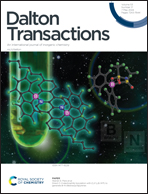Ionic conduction in ammonia functionalised closo-dodecaborates MB12H11NH3 (M = Li and Na)†
Abstract
Metal hydroborates and their derivatives have been receiving attention as potential solid-state ion conductors for battery applications owing to their impressive electrochemical and mechanical characteristics. However, to date only a fraction of these compounds has been investigated as solid-state electrolytes. Here, MB12H11NH3 (M = Li and Na) hydroborates are synthesized and investigated as electrolyte materials for all-solid-state batteries. The room temperature α-NaB12H11NH3 was structurally solved in P212121 (a = 7.1972(3) Å, b = 9.9225(4) Å, and c = 14.5556(5) Å). It shows a polymorphic structural transition near 140 °C to cubic Fm![[3 with combining macron]](https://www.rsc.org/images/entities/char_0033_0304.gif) m. LiB12H11NH3 and NaB12H11NH3 exhibit cationic conductivities of σ(Li+) = 3.0 × 10−4 S cm−1 and σ(Na+) = 1.2 × 10−4 S cm−1 at 200 °C. Hydration is found to improve ionic conductivity of the hydroborates. It is presumed that modest ionic conductivities could be due to a lack of significant re-orientational dynamics in the crystal structure resulting from the presence of the bulky –NH3 group in the anion.
m. LiB12H11NH3 and NaB12H11NH3 exhibit cationic conductivities of σ(Li+) = 3.0 × 10−4 S cm−1 and σ(Na+) = 1.2 × 10−4 S cm−1 at 200 °C. Hydration is found to improve ionic conductivity of the hydroborates. It is presumed that modest ionic conductivities could be due to a lack of significant re-orientational dynamics in the crystal structure resulting from the presence of the bulky –NH3 group in the anion.



 Please wait while we load your content...
Please wait while we load your content...